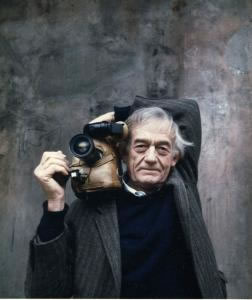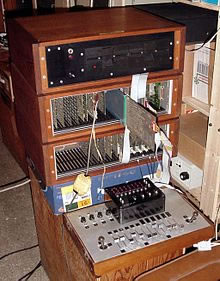Shown here are some photos me sitting at the KINSYN I system I developed at MIT with my grad student Walt Maurer. (The photo is probably from about 1970 judging from my hair!)
The system was based around an 8K IBM 1130 (that's right, just 8 K words!) computer running a home-made dynamic display constructed out of a bare-bones Textronix storage tube with a wire-wrapped circuit board designed by Dick Sidell mounted on the back. The digital computer sent vectors to an EAI 680 analog computer where they were converted to analog voltages that drove a bouncing spot back and forth between the vector end points so rapidly that they didn't have a chance to store. Fixed graphics were drawn in storage mode and the dynamic parts of the image were done with this Rube Goldberg technique. This computer was running a full level H FORTRAN compiler we developed within the Mechanical Engineering Department since IBM had only released a level E compiler for that machine. If you wanted to use features like complex arithmetic you needed to write your own compiler!
The graphic input devices were also one-of-a-kind. The tall device in the photo below shows our first graphical input device. I designed it and my undergraduate student, John Alba built it as his bachelor's thesis. It used a unique spatial telescoping joy-stick linkage coupled to a pair of sine-cosine potentiometers so as to simplify the calculations needed to get X-Y coordinate data into the computer via an A to D converter. This gadget eliminated the need for the computer to invoke arctangent calculations which would have required swapping all of the contents of the computer's memory out to disk repeatedly inside of loops. (Doing dynamic graphics on such a tiny primitive system meant you needed to eliminate every possible excess line of code!)
The "bowling ball" input device was possibly one of the first prototype trackballs ever made. I rescued it from the trash at Project MAC and we adapted it as our second generation graphic input device. I believe it might have been part of Ivan Sutherland's original Sketchpad computer system. (Remember- this was long before the days of computer mice and we couldn't afford the light pens and sonic tablets that were commercially available.)
Here are some photos of KINSYN I being used to interactively synthesize the world's first orthotic knee brace that would exactly match the X-ray data for a patient's knee at four or five precision positions.
These photos show KINSYN I being used to interactively synthesize a mechanism for a high-speed ground transport system that was being designed at MIT. Other photos show some of the optimization capabilities of the system, the ability of the system to interactively utilize graph theory to develop on the fly closed-form equations for analyzing multi-link mechanisms such as six and eight bar mechanisms, Peucellier mechanisms, and the like.
Although it looks as if the KINSYN 1 movie was shot in broad daylight, in reality the entire room was so dim that you couldn't see across the room. Tthe home-made computer display system was based around a bare-bones Tektronix storage oscilloscope being driven by the IBM 1130 through A to D converters running on the EAI 680 analog computer seen in the background. Custom wire-wrapped circuit boards on the back of the display allowed us to perform dynamic graphics on what was essentially a storage tube device.
In order to make the film, Ricky needed to resort to all sorts of exposure trickery. Tthe entire scene needed to be illuminated at the same intensity as the faint green trace on the storage tube display and Ricky needed to have the lab push process the film by about 4X.

Also of note: The music for the KINSYN 1 sound track was composed for the film and played by the early computer music pioneer, John Appleton. At the time he was on the faculty at Dartmouth College where he had created one of th first electronic music studios in the United States. Later, in the mid 1970's, he developed the first commercial digital synthesizer, the Synclavier. The music for KINSYN 1 was composed on a much larger lab-filling prototype device, the "Dartmouth Digital Synthesizer".
